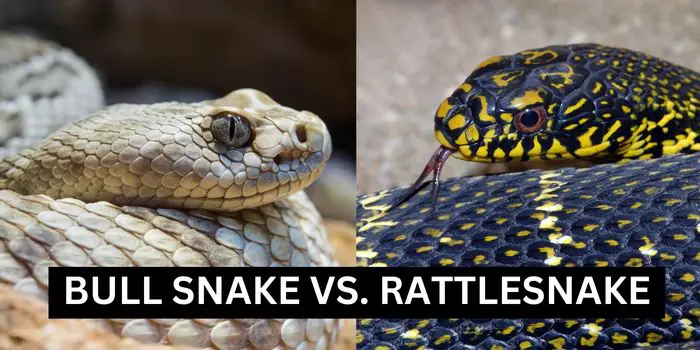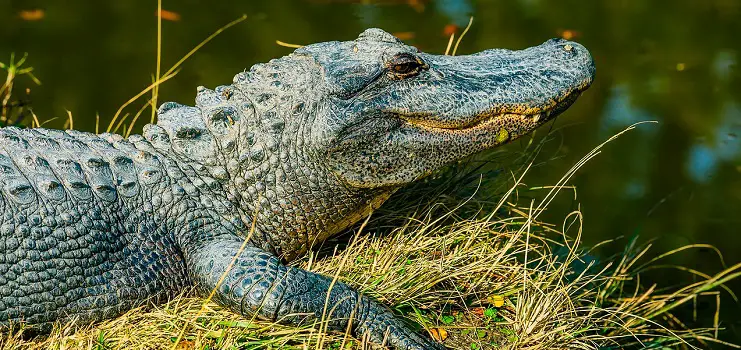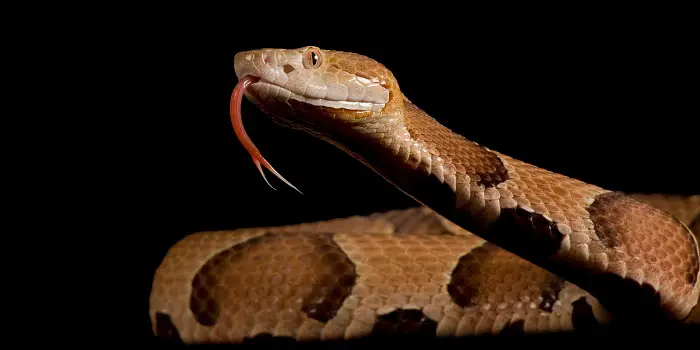
Bull snakes and rattlesnakes are the two species of scariest snakes found in North America.
Both these species are capable of inflicting serious bites, but there is a difference in the level of venom they possess.
Although bullsnakes are nonvenomous, they can still bite you.
Rattlesnakes, on the other hand, have venom that could potentially kill an adult if not treated immediately upon being bitten.
With that said, it is believed that bullsnakes are more aggressive than rattlesnakes; they often times chase after humans and animals much more easily than a rattlesnake would.
Rattlesnakes may be more dangerous overall, but they are usually shyer than bullsnakes.
Do you like the story till now? Want to know more about these two snakes? Yes?
Let’s go ahead and know some more differences between these two snakes so that if you happen to encounter any of these in the wild or on your property, you’ll know how to identify them and what to do.
Bull Snake and Rattlesnake – How They Kill?
Bullsnakes and rattlesnakes eat the same foods, given that they are both carnivorous snakes.
However, their method of killing prey is quite different.
Bullsnakes squeeze their meals before swallowing them whole, whereas rattlesnakes choose to utilize their powerful venom to achieve the same end result.
Rattlesnakes also have an advantage over bullsnakes when it comes to hunting. Rattlesnake facial pits allow them to detect prey at night, a pit viper feature that bullsnakes do not have.
Bullsnakes vs. Rattlesnakes: The Presence of Rattle
The presence of a rattle is one of the most telling differences between bullsnakes and rattlesnakes.
Rattlesnakes are well-known for their rattling tails, and they use them as a warning to predators who come too close.
Bullsnakes do not have a rattle on their tails, but they do something that may be difficult to understand at first.
Bullsnakes, on the other hand, can produce a low growling or rumbling sound from within, much like rattlesnakes.
They make this noise by clicking their chests instead of rattling from an external tail.
They also coil up similarly to rattlesnakes and may cause people to mistake them for bullsnakes vs. rattlesnakes when attempting to distinguish between the two species.
Rattlesnake vs. Bullsnake: Their Body Markings and Head Shape
While it may be hard to distinguish between the two, at first sight, there are ways to tell them apart based on their unique markings.
When compared to bullsnakes, rattlesnakes have a far more distinct and unique pattern along their back.
They can have a striped or diamond design, earning them the name “diamondback,” which is what happens when you combine the words “toad” and “back.”
They exist in many hues, ranging from dark brown to pale pink than bullsnakes do.
Bullsnakes can also be patterned, although their markings are typically more muddled and streaked when compared to rattlesnakes.
The majority of bullsnakes have a pale yellow or brown color with orange or red markings that have faded.
Do Bullsnakes Repel Rattlesnakes – Will They Fight or Kill Each Other?
Although bullsnakes and rattlesnakes are similar in size and live in many of the same places, people often believe that bullsnakes kill rattlesnakes.
This myth is incorrect. Bullsnakes do not actively hunt down or eat rattlesnakes (or any other snake) with the exception of very small dead snakes (when given an opportunity) who pose no threat.
Although many people believe that bullsnakes kill rattlesnakes and, therefore, also serve as a repellent, this assertion is false.
In fact, there is no need to keep bullsnakes in your tent when camping – they will not protect you from any danger posed by rattlers (as many campers believe to be true).
Bullsnakes and rattlesnakes both want to eat and live, so they don’t naturally repel each other.
But people often mistake bullsnakes for rattlesnakes (which is venomous and dangerous) and kill them because of this false belief.
The conclusion
It’s not always easy to tell them apart because they share some physical characteristics, but bullsnakes usually have different markings than rattlesnakes.
Bullsnakes kill by constriction and don’t have rattles like their venomous cousins, the rattlesnake.
Although bullsnakes are nonvenomous and their bite is comparatively harmless compared to that of a rattlesnake, they are an aggressive snake species that has been known to chase after humans or animals if startled.
It’s always wisest to steer clear of a bullsnake if you come across one.
Share the post "Bull Snake vs. Rattlesnake – Which is More Venomous?"

Welcome to ProShieldPest.com. I am Tina Jones. I have been working as a pest removal professional in Winslow, Arizona lately. At present, I love to spend my time with my family as a retiree.
Here I share all my knowledge and experiences to help people understand better how they can stop pests at their homes without actually killing them. Hopefully, the information you will find here will help in safeguarding your home! You can check more about me here.




